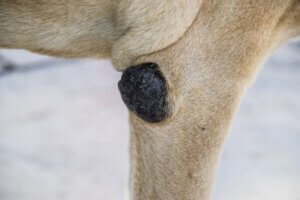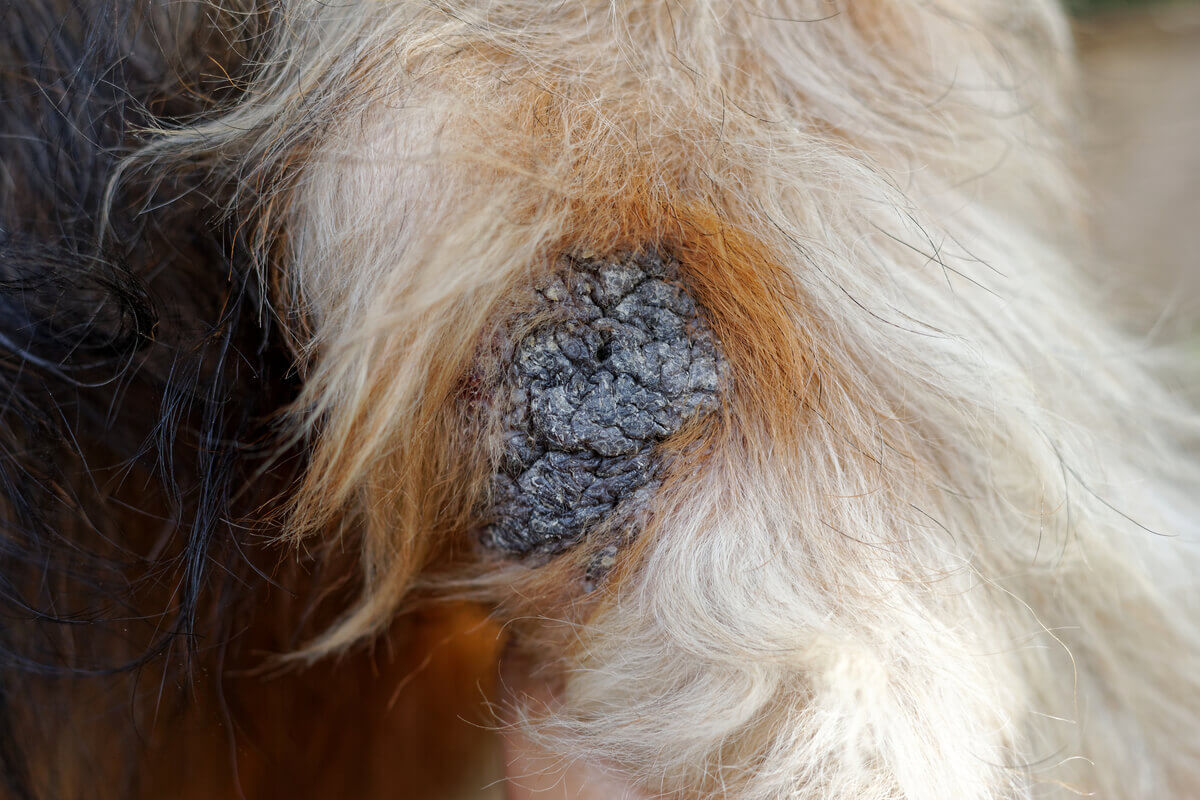How to Treat and Moisturize Calluses in Dogs?

Calluses, those thick patches that sometimes appear on dogs’ legs, are usually nothing more than the natural consequence of leaning on them. However, just like the calluses on our feet, we must care for these issues in order to avoid problems. Here, we’ll tell you how to treat and moisturize calluses in dogs.
Below, you’ll find a definition of calluses, or corns, and frequent problems that can result from them. As the popular refrain goes, prevention is always the best medicine. So we’ll also tell you how you can treat and moisturize calluses in dogs.
What are calluses?
We can define a callus as the formation of keratosis on the skin. To put it another way, it’s a thickening in a specific area of the skin, usually well-defined, where the hair has stopped growing.
This occurs when the dog tends to always rest in the same position. For example, lying like a sphinx, resting on its elbows. If the surface is hard and the position is very recurrent, the dog’s skin becomes thick in order to protect the bone.
Thick-haired breeds – Border Collies or Spaniels for example – are relatively more exempt from developing calluses. This is because their coat protects them against pressure. On the contrary, large breeds, such as Labradors or Mastiffs, tend to develop them more easily due to their weight and short hair.

When is it time to treat and moisturize calluses in dogs?
As we said at the beginning of this article, calluses are normal and the only impact they have is aesthetic. However, sometimes they can lead to complications in one of the following ways:
- Ulcers and cracks: Since the callus is thickened and keratinized, it can crack, causing pain, discomfort, and bleeding in the animal.
- Pyodermas: Skin in this state is also susceptible to infection, especially if it’s become cracked.
- Pain and discomfort: If the callus is too thick and too dry, it may cause itching and pain when the animal leans on it. As a result, the dog may have a hard time finding a comfortable position to rest in.
When this happens, a brief visit to the veterinarian can quickly solve this problem. However, since prevention is usually the cheapest and most convenient route, here’s how to treat and moisturize calluses in dogs so that your dog doesn’t have to suffer.
How to prevent the appearance of calluses
Just like calluses on humans, in their normal state, they’re nothing more than something you’d want to treat from an aesthetic perspective. Here are 4 essential points to prevent their appearance.
1. Provide a soft surface to rest on
The formation of calluses is directly proportional to the hardness of the surface where the dog rests. That’s to say, if the dog sleeps or rests on dirt, stone, or similar types of floor, it’s much more likely to develop calluses.
To keep this from happening, it’s best to provide a bed or a soft surface for the dog to rest on. This won’t only prevent calluses, but will also provide your dog with better rest.
2. Take into account the temperature
It’s common to observe that dogs don’t use their usual resting place during hot weather. A particularly warm bed will delight them in winter, but, in summer, they may seek cool surfaces to rest on. For example, a marble floor or a shady patch of ground.
To ensure that dogs continue to use their beds in the summer, it’s important to provide a bed made of materials that are neutral in terms of heat retention. This means avoiding velvet and furs. It’s best for fabrics to be breathable and washable. And you should be able to cover them with blankets or warm clothing in winter and cooling blankets in summer.
3. Avoid allowing your dog to become overweight
A heavier animal means more pressure on the skin when resting. A dog that’s not overweight won’t only be able to avoid all the associated health complications. It’ll also be able to rest, avoiding calluses and pressure ulcers.
4. Maintain proper hygiene where your dog rests
Where your dog rests should be as clean as possible. The animal can’t rest where it eats or goes to the bathroom. They themselves usually avoid it, so you must wash the area on a fairly frequent basis. That way, opportunistic infections are avoided.
If the dog already has a callus or some kind of wound, this could lead to pyoderma.
How to treat and moisturize calluses in dogs?
As a preventive measure, you can buy a cream or wax to apply to your dog’s corns on a regular basis or when they’re especially dry. If this cream contains aloe vera and vitamin E, all the better. Aloe vera has great moisturizing power and vitamin E is an antioxidant, which will help prevent the skin from cracking.
It’s important to make sure that your dog doesn’t ingest these creams, so you’ll need to keep an eye on the animal until the ointment is absorbed. The best time to apply it is after a bath.
Pad wax is also often used for calluses on elbows and other places. Be sure to check with a specialist or pet store first before applying it.
If the calluses have already developed into ulcers or pyoderma, you’ll need to see a veterinarian for treatment. An infection can be serious and shouldn’t be left for another day.

Calluses, those thick patches that sometimes appear on dogs’ legs, are usually nothing more than the natural consequence of leaning on them. However, just like the calluses on our feet, we must care for these issues in order to avoid problems. Here, we’ll tell you how to treat and moisturize calluses in dogs.
Below, you’ll find a definition of calluses, or corns, and frequent problems that can result from them. As the popular refrain goes, prevention is always the best medicine. So we’ll also tell you how you can treat and moisturize calluses in dogs.
What are calluses?
We can define a callus as the formation of keratosis on the skin. To put it another way, it’s a thickening in a specific area of the skin, usually well-defined, where the hair has stopped growing.
This occurs when the dog tends to always rest in the same position. For example, lying like a sphinx, resting on its elbows. If the surface is hard and the position is very recurrent, the dog’s skin becomes thick in order to protect the bone.
Thick-haired breeds – Border Collies or Spaniels for example – are relatively more exempt from developing calluses. This is because their coat protects them against pressure. On the contrary, large breeds, such as Labradors or Mastiffs, tend to develop them more easily due to their weight and short hair.

When is it time to treat and moisturize calluses in dogs?
As we said at the beginning of this article, calluses are normal and the only impact they have is aesthetic. However, sometimes they can lead to complications in one of the following ways:
- Ulcers and cracks: Since the callus is thickened and keratinized, it can crack, causing pain, discomfort, and bleeding in the animal.
- Pyodermas: Skin in this state is also susceptible to infection, especially if it’s become cracked.
- Pain and discomfort: If the callus is too thick and too dry, it may cause itching and pain when the animal leans on it. As a result, the dog may have a hard time finding a comfortable position to rest in.
When this happens, a brief visit to the veterinarian can quickly solve this problem. However, since prevention is usually the cheapest and most convenient route, here’s how to treat and moisturize calluses in dogs so that your dog doesn’t have to suffer.
How to prevent the appearance of calluses
Just like calluses on humans, in their normal state, they’re nothing more than something you’d want to treat from an aesthetic perspective. Here are 4 essential points to prevent their appearance.
1. Provide a soft surface to rest on
The formation of calluses is directly proportional to the hardness of the surface where the dog rests. That’s to say, if the dog sleeps or rests on dirt, stone, or similar types of floor, it’s much more likely to develop calluses.
To keep this from happening, it’s best to provide a bed or a soft surface for the dog to rest on. This won’t only prevent calluses, but will also provide your dog with better rest.
2. Take into account the temperature
It’s common to observe that dogs don’t use their usual resting place during hot weather. A particularly warm bed will delight them in winter, but, in summer, they may seek cool surfaces to rest on. For example, a marble floor or a shady patch of ground.
To ensure that dogs continue to use their beds in the summer, it’s important to provide a bed made of materials that are neutral in terms of heat retention. This means avoiding velvet and furs. It’s best for fabrics to be breathable and washable. And you should be able to cover them with blankets or warm clothing in winter and cooling blankets in summer.
3. Avoid allowing your dog to become overweight
A heavier animal means more pressure on the skin when resting. A dog that’s not overweight won’t only be able to avoid all the associated health complications. It’ll also be able to rest, avoiding calluses and pressure ulcers.
4. Maintain proper hygiene where your dog rests
Where your dog rests should be as clean as possible. The animal can’t rest where it eats or goes to the bathroom. They themselves usually avoid it, so you must wash the area on a fairly frequent basis. That way, opportunistic infections are avoided.
If the dog already has a callus or some kind of wound, this could lead to pyoderma.
How to treat and moisturize calluses in dogs?
As a preventive measure, you can buy a cream or wax to apply to your dog’s corns on a regular basis or when they’re especially dry. If this cream contains aloe vera and vitamin E, all the better. Aloe vera has great moisturizing power and vitamin E is an antioxidant, which will help prevent the skin from cracking.
It’s important to make sure that your dog doesn’t ingest these creams, so you’ll need to keep an eye on the animal until the ointment is absorbed. The best time to apply it is after a bath.
Pad wax is also often used for calluses on elbows and other places. Be sure to check with a specialist or pet store first before applying it.
If the calluses have already developed into ulcers or pyoderma, you’ll need to see a veterinarian for treatment. An infection can be serious and shouldn’t be left for another day.

All cited sources were thoroughly reviewed by our team to ensure their quality, reliability, currency, and validity. The bibliography of this article was considered reliable and of academic or scientific accuracy.
- Yotti Álvarez, C. L. (2010). Novedades en el diagnóstico y tratamiento de la Pioderma canina. Revista del COLVEMA. http://www.colvema.org/pdf/1215pioderma.pdf
- Guerrero Fernández de Córdova, G. F. Evaluación de fracturas diafisiarias, formación del callo ciatrizal hasta la curación clínica, con la utilización de symphytum en pacientes caninos entre 12 a 48 meses de edad.
This text is provided for informational purposes only and does not replace consultation with a professional. If in doubt, consult your specialist.








